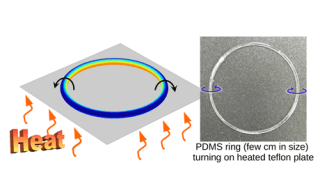May 4 2018
Physicists and material scientists have been successful in building a motor and an energy storage device from a single component. They used an elastic polymer fiber closed into a ring that was designed to rotate on application of an external energy supply.
The researchers from the Universities in Heidelberg and Strasbourg (France) expect that this mechanism will accelerate the creation of intelligent materials with well-defined functions. The details of the research are published in the journal “Nature Materials”.
 (Image credit: Falko Ziebert)
(Image credit: Falko Ziebert)
“Our approach is minimalistic. We don’t rely on complex, high-tech materials but instead ask ourselves how the geometry and topology of a piece of material can elicit an intelligent function, such as rotation. That's how our wheel within came about,” reports Dr. Falko Ziebert of the Institute for Theoretical Physics at Heidelberg University, who co-directed the study with Dr Igor Kulić of the Institut Charles Sadron of the University of Strasbourg.
In contrast to a traditional rigid wheel that moves around an axle, an elastic deformation wave develops this wheel within, causing it to move.
Simple heat flow generates the propulsion by causing thermal expansion in the material, much like the thermal convection in our atmosphere that determines our weather and climate. This thermal deformation interacts with the prescribed deformation of the ring geometry and elicits the rotation.
Dr. Falko Ziebert
With the wheel within, the researchers realized a very simple principle to set polymer materials, like a rubber band or a nylon thread, into spontaneous motion. This principle will be the foundation for the research going forward.
“Right now we are still playing with different geometries, materials, and other forms of energy flow through the system,” states Dr Kulić. One vision is to create new technical devices with strong, self-propelled elements, in the form of artificial muscles, for example. Scientists from the Swiss Federal Institute of Technology in Zurich (Switzerland) also assisted in the study.